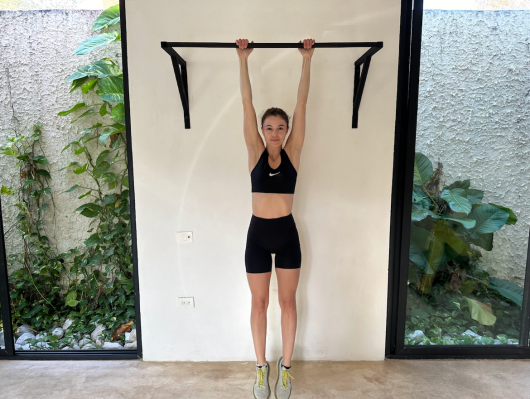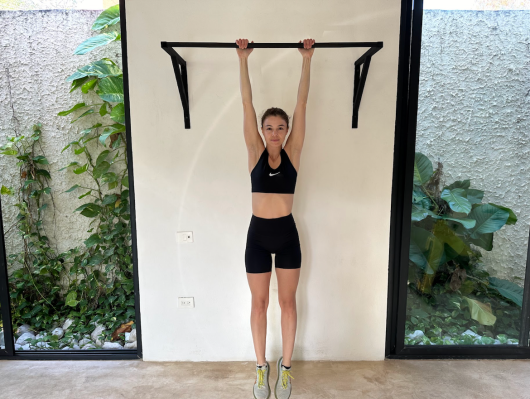And the truth is, adding this simple move to your workout could come with a lot of benefits, like reduced back pain and a stronger upper body.
That said, unless pull-ups are already part of your workout program, getting started with dead hangs is no easy task; as a beginner, you might be hard-pressed to hold on for even a few seconds.
Experts In This Article
Here’s how exercise pros recommend getting started with dead hangs, plus the impressive benefits you stand to reap from them.
In This Article
How to do a dead hang
Among the many people doing dead hangs on TikTok, there are some with not-so-great form. Here’s how to do a dead hang correctly, according to Matthew Accetta, ACSM-CEP, CSCS*D, CSPS, an exercise physiologist at the Hospital for Special Surgery.

- Step up onto a box or bench below a pull-up bar.
- Grab the pull-up bar with both hands, shoulder-width apart, palms facing away from you, with your thumb wrapped around the bar.
- Step off the box and allow your body to hang directly below the bar, legs extended toward the floor. Keep your arms fully extended with no bend at your elbows.
- Completely relax your body.
- Hold this position for 5 to 60 seconds.
- Do 3 reps, taking time to rest in between.
“One of the most common mistakes people make is incorporating swinging movements, which you should not do when performing dead hangs,” says Jason De Melo, CrossFit level 1 coach and director of coaching for D1 Training.
That’s because if you’re making any sort of effort—whether it’s swinging, trying to retract your shoulder blades, or even holding your legs or feet up—you’ll be asking some muscles to work. When you engage any of your muscles, you’re not going to be passively stretching and reaping the benefits of the dead hang, Accetta explains.
Another no-no: Jumping up to the bar, Accetta says. Unless you’re an advanced athlete, it can be risky to jump up to try to grab the bar, because that means you always have a fair distance to fall if you miss or when you drop back down to the floor after hanging. It’s a great way to roll an ankle—and totally not worth it for a simple dead hang.
If you find that hanging with your arms directly overhead isn’t comfortable for your shoulders, try hanging with a neutral grip on a pull-up station or monkey bars, with your palms facing in towards each other, Accetta says. This can be helpful for people with more limited shoulder mobility.
Benefits of a dead hang
“Dead hangs offer several benefits, including improved grip strength, enhanced shoulder mobility, spine decompression, upper- body stretching, and assistance in correcting posture,” De Melo says.
If you spend all day on your feet or sitting at a desk, decompressing your spine may be an especially enticing perk. Not only does it feel good, but hanging is also doing some real behind-the-scenes work in your spine.
Here’s how it works: “Throughout the day, there are a lot of vertical forces on our spine; gravity is pulling on our spine and kind of smushing it together,” Accetta explains.
Your spine is made up of 26 bones including your vertebrae, which are separated by gel-like discs that provide cushioning to the spinal column, according to the National Library of Medicine. These discs allow the spine to be flexible and act as shock absorbers during activities like walking, running, and jumping. As we age, those discs lose the ability to reabsorb fluid and become brittle and flatter, and research shows1 that prolonged sitting can even have an effect on intervertebral disc health.
Typically, “when we’re sleeping, we’re laying flat on our spine, those vertical compressions go away and our spine has some time to elongate and the discs can rehydrate,” Accetta says. “But throughout the day, just through standing, sitting in a chair, gravity is pushing down on us vertically and that really causes our spine to compress.”
And that’s where dead hangs come in. “When you hang from that bar, it provides some tension relief and lets the spine briefly open up a little bit, enough so some of those discs can rehydrate, get more nutrients, and recover faster,” Accetta explains.
Hanging can have other postural perks, too. “They help to stretch out the shoulders, open up the chest, and pull and cinch everything back,” Accetta says. In case you didn’t know, tight chest muscles are a hallmark of poor, forward-rounded posture; stretching them allows you to correct that pattern. “And dead hangs provide great shoulder stabilization because they help stabilize the rotator cuffs and allow them to become stronger in a passive position,” he adds.
Truly, the main group of muscles dead hangs help strengthen instead of stretch? Those involved in your grip. Dead hangs are fantastic for improving grip strength, which has been linked in many studies2 to better health outcomes3, including reduced risk of early death, better cognitive function4, and slower aging.
Another perk? All that grip strength can also translate to progress toward nailing pull-ups (if that’s your goal), per the National Academy of Sports Medicine.
“When you hang from that bar, it provides some tension relief and lets the spine briefly open up a little bit, enough so some of those discs can rehydrate, get more nutrients, and recover faster.” —Matthew Accetta, ACSM-CEP, CSCS*D, CSPS
Tips for getting started if you’ve never done a dead hang before
If you’re a beginner to exercise or don’t train pull-ups, it’s very possible hanging from a pull-up bar is too hard—no shade, it’s surprisingly difficult for a move that involves, well, not moving.
Instead, try an inverted row using a barbell or TRX, or a supported dead hang with a large-loop resistance band to support part of your body weight, Accetta says. “For people that have never done dead hangs or don’t have the upper-body strength to hold themselves up, that’s a good place to start,” he says. With these modifications, you’ll still work your grip strength and feel some of those spinal-decompression benefits.
Remember what Accetta said about not jumping up to the bar? De Melo seconds that. “It’s important to utilize a box or similar object to reach the hanging bar safely,” he says.
Once you are able to hang, start with as little as five seconds at a time. “Initially, you may find it challenging to hang for extended periods, so I always advise that individuals break the exercise up into shorter intervals,” De Melo adds. Both experts agree that dead hangs are a great warmup or cooldown exercise, and recommend doing about three reps with rest in between.
FAQ
1. Is there anyone who shouldn’t do dead hangs?
As a general rule, Accetta recommends checking with your doctor or a trainer to see if dead hangs are a good choice for you personally. This is especially true if you have any shoulder or back issues. And if you’re unsure how to try the modifications, work with a trainer who can get you set up, he says.
2. What muscles does dead hanging build?
Dead hangs primarily work the muscles involved in grip strength, according to a small 2015 study in Experimental Brain Research. These include your hands and the flexor digitorum profundis, flexor pollicis longus, and extensor digitorum communis—three muscles found in your forearms.
Dead hangs can also help strengthen your rotator cuff, Accetta says, which is a group of muscles and tendons that hold your shoulder joint in place.
3. How long should I be able to dead hang?
There’s no set amount of time you need to be able to dead hang for; a reasonable goal will depend on your age, body, and abilities. That said, “ideally, anywhere between 10 to 30 seconds is pretty good,” Accetta says. “If you can hang for a minute, that’s great. I wouldn’t really push it past that… you kind of reach full benefit right away.”
Well+Good articles reference scientific, reliable, recent, robust studies to back up the information we share. You can trust us along your wellness journey.
- Billy GG, Lemieux SK, Chow MX. Changes in lumbar disk morphology associated with prolonged sitting assessed by magnetic resonance imaging. PM R. 2014 Sep;6(9):790-5. doi: 10.1016/j.pmrj.2014.02.014. Epub 2014 Mar 2. PMID: 24594305; PMCID: PMC4152382.
- Bohannon RW. Hand-grip dynamometry predicts future outcomes in aging adults. J Geriatr Phys Ther. 2008;31(1):3-10. doi: 10.1519/00139143-200831010-00002. PMID: 18489802.
- Celis-Morales C A, Welsh P, Lyall D M, Steell L, Petermann F, Anderson J et al. Associations of grip strength with cardiovascular, respiratory, and cancer outcomes and all cause mortality: prospective cohort study of half a million UK Biobank participants BMJ 2018; 361 :k1651 doi:10.1136/bmj.k1651
- Bardo A, Kivell TL, Town K, Donati G, Ballieux H, Stamate C, Edginton T, Forrester GS. Get a Grip: Variation in Human Hand Grip Strength and Implications for Human Evolution. Symmetry. 2021; 13(7):1142. https://doi.org/10.3390/sym13071142
- Ambike S, Paclet F, Zatsiorsky VM, Latash ML. Factors affecting grip force: anatomy, mechanics, and referent configurations. Exp Brain Res. 2014 Apr;232(4):1219-31. doi: 10.1007/s00221-014-3838-8. Epub 2014 Jan 31. PMID: 24477762; PMCID: PMC4013148.
Source: Well and Good









